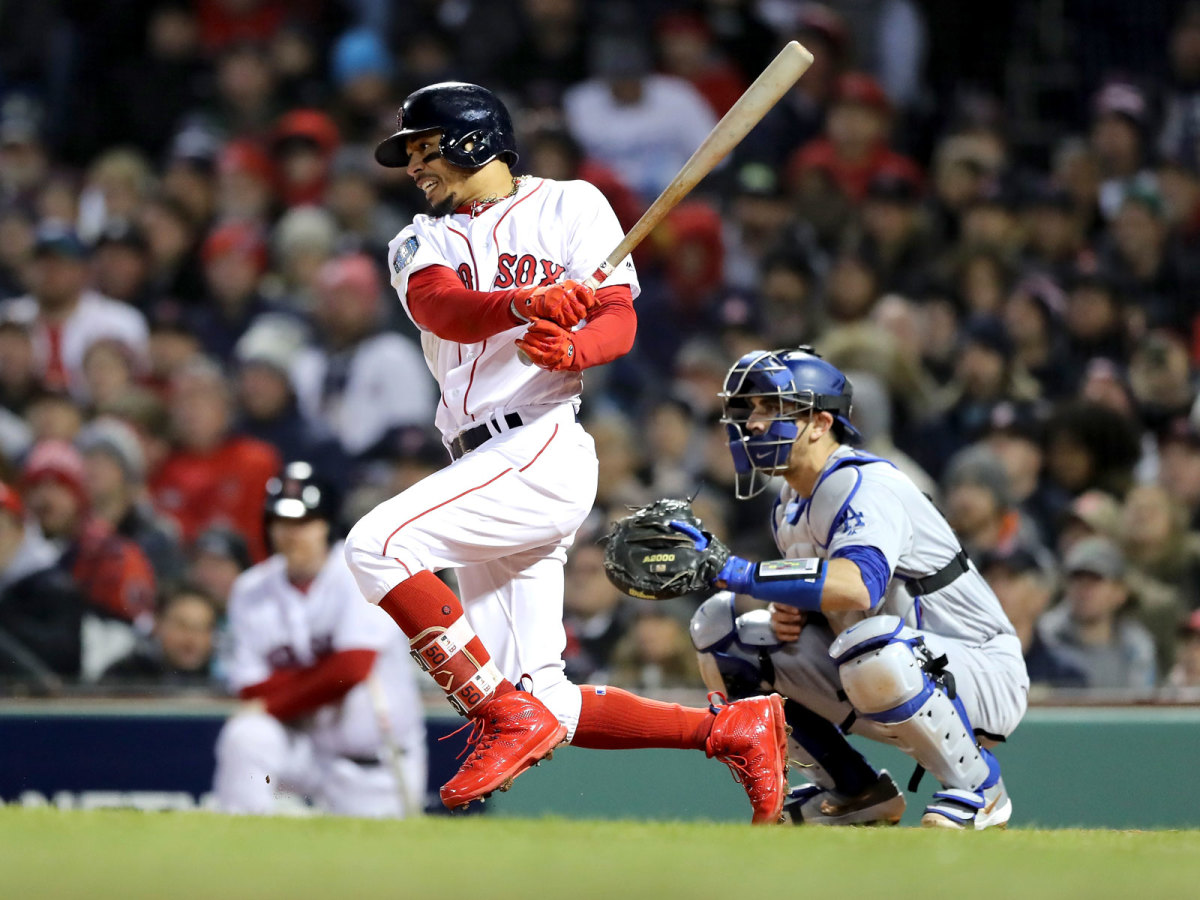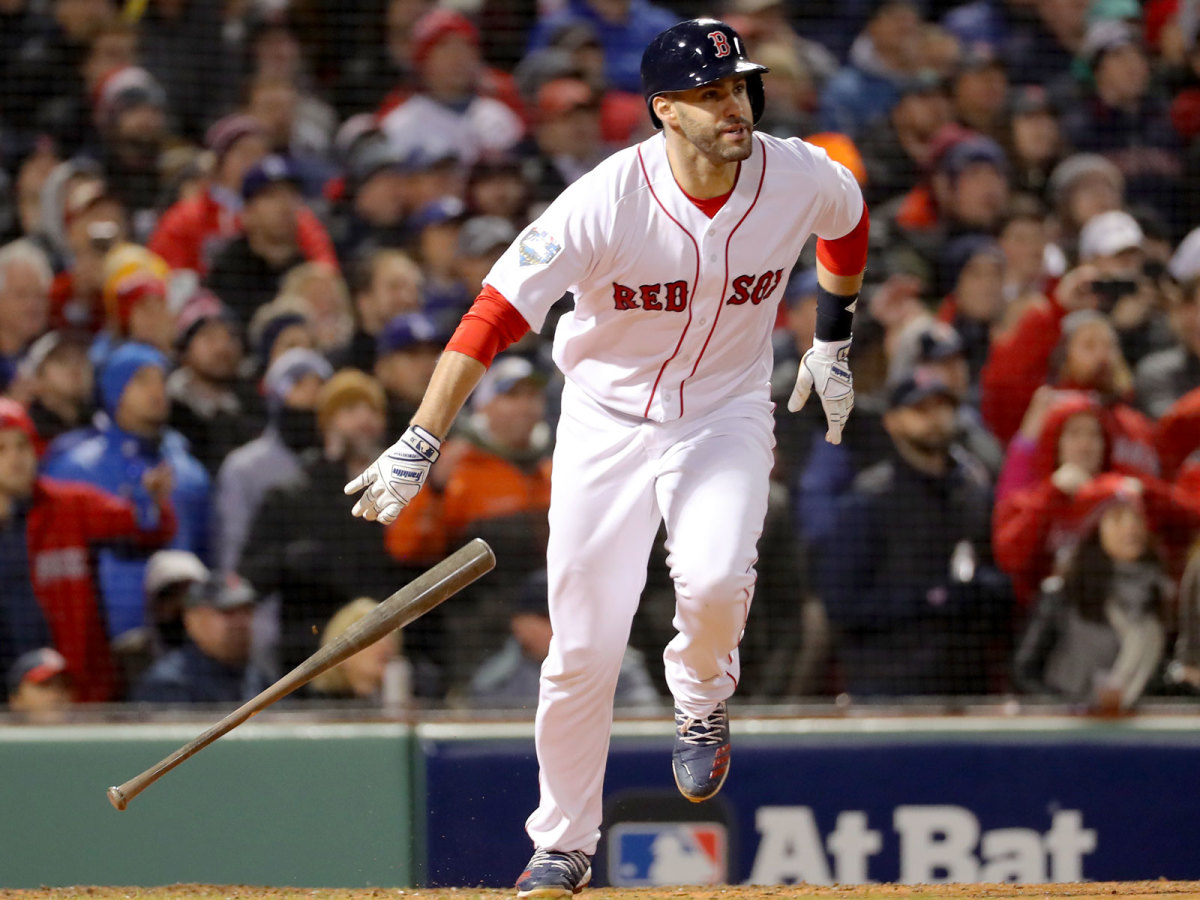How a Spring Training Drill Keyed the Red Sox' Game 2 Win Over the Dodgers

BOSTON — If the English won Waterloo on the playing fields of Eton, the Boston Red Sox won World Series Game 2, if not the series in its entirety, on the backfields of Fort Myers. As Boston rookie manager Alex Cora and his staff planned spring training last January, hitting coach Tim Hyers came to him with an idea: a dedicated station on a back field just for situational hitting.
“I loved it,” Cora said. “I’ve heard people say a strikeout is just another out. I never believed that was true.”
Hyers set up a pitching machine on the field and either cranked it to his maximum velocity—not quite 100 mph—or programmed it to spit out nasty breaking balls.
“Because when you get to two strikes,” Hyers said, “that’s what you’re going to see. The idea was to get away from your ‘A’ swing and go to a ‘B’ swing. We practiced just fighting off the pitch. Just get to another pitch.”
Imagine that: batting practice in which just a foul ball meant success. Cora would swing through the station and shout, “Fight it off! Fight it off! Win the at-bat!”
Seven months later, hello, Waterloo.
The Red Sox trailed Los Angeles, 2–1, in the fifth inning Wednesday night, in danger of letting the Dodgers go back to Los Angeles with a split of the two games at Fenway Park, thus wresting home field advantage in the series. The inning was as close to being over as any inning can be: two outs, nobody on base and an 0-and-2 count to the number nine hitter, Christian Vazquez.
But here’s what happened just when the Dodgers should have been off the field: the Red Sox refused to go away. The next five batters went single, single, walk, walk, single. Nobody pulled the ball. All seven pitches thrown with two strikes failed to get a third strike. By the end of that five-batter sequence, the game was over. The Red Sox led 4–2—which would stand as the final because they ran out three relievers who made that Fort Myers pitching machine look wimpy. One of the greatest closers of the past seven years, Craig Kimbrel, was the soft-tosser among the group after Joe Kelly and Nathan Eovaldi whipped 100-mph aspirin tablets plateward.
If you could frame a rally and hang it on a wall, this is the one that would go over the mantle of the Red Sox’s 2018 season. What the Lansdowne portrait was for George Washington, the fifth inning of Game 2 will be for Boston.
The Dodgers figure to play better in the warmth and spaciousness of Dodger Stadium and under National League rules. They looked uncomfortable in the chill and confines of Fenway, to the point of players rushing to put on jackets after each half inning in the field.
More importantly, for a second straight night they discovered their pitchers lack the premium stuff to put away these Red Sox hitters, who treat every at-bat like martial artists trained to the highest level in hand-to-hand combat. Los Angeles is losing this World Series one at-bat at a time.
The downfall began with Hyun-jin Ryu unable to find a way to get a third strike on Vazquez, the Boston catcher. Vazquez hit .137 this year after he fell behind 0-and-2. But in the World Series he became as immutable as iron. Ryu tried to finish him off with a cutter, but Vazquez—straight out of Fort Myers—fouled it off to get to another pitch. That next pitch, a fastball, was a ball that barely missed the zone.
“With two strikes I was just trying not to do too much,” Vazquez said. “I was just trying to see the ball and swing at strikes.”
The next pitch was a cutter away. With an abbreviated swing, Vazquez poked it into rightfield for a single.
“The perfect example of going to a ‘B’ swing,” Hyers said.
Mookie Betts batted next. The dude is the presumptive MVP of the league, but not above the dark arts of the backfields of Fort Myers. The average major league hitter bats .178 in two-strike counts. Betts hit an absurd .300, the baseball equivalent of landing a triple Salchow as far as degree of difficulty. Betts is the first player in 18 years to be a .300 hitter with two strikes (minimum 300 at-bats). You can only do that with a flat, quick stroke.
This time Betts was behind the count, but not yet at two strikes. At 0-and-1, he pulverized a cutter from Ryu with a flat swing into centerfield for a single.

Then Andrew Benintendi stepped in for something that was more performance art than an at-bat. He was in the batter’s box for six minutes. The Dodgers held half of their entire game’s worth of mound visits just trying to figure out how to make Benintendi go away. They could not do it. Ryu, who had finished him with curveballs on his first two at-bats, tried eight pitches against him. At a full count, he threw two curveballs. But this time Benintendi fouled off both.
Flummoxed, Ryu and catcher Austin Barnes gave the pitching equivalent of throwing their hands up. They gave up and went away from the curveball, though Benintendi had just two hits all year on curveballs from lefthanders. The foul balls—imported from Fort Myers—had swayed them into something else. Ryu tried a fastball, but he had no conviction behind the pitch. It was a terrible pitch—a ball out of his hand immediately, and Benintendi took it without much thought for ball four.
“All I was trying to do was just put it in play,” he said.
Nobody in the American League had more opposite field hits this year than Benintendi, who collected 40 of his 60 hits the other way at Fenway.
“Benny has made huge strides this year,” Hyers said. “He makes adjustments in game that you see from seven- or eight-year guys, not second-year guys. It’s been amazing to watch.”
Benintendi’s six-minute at-bat forced Dodgers manager Dave Roberts to summon righthander Ryan Madson to face the righthanded-hitting Steve Pearce. Cora stuck with Pearce over lefty switch-hitting option Mitch Moreland, and of course Cora, who at this rate would be a shoo-in to hit the Powerball if he bought a ticket, was right again. Pearce walked, forcing home the tying run.

The next batter, J.D. Martinez, looked at one ball before he took an inside 95-mph fastball and humbly carved it into rightfield for a two-run single. The 2-1 Dodger lead had flipped into a 4-2 Red Sox lead, quickly, bloodlessly, and humbly.
“We’ve been doing it all year,” Cora said.
It’s hard to remember a team that plays offensive baseball like the Red Sox. Red Sox president of baseball operations Dave Dombrowski has been in the game for 41 seasons. When I put that question to him, he said, “It’s so hard to compare because the game has changed so much. We had teams in Detroit that scored a lot of runs, but because of the power and the strikeouts in the game today, it’s hard to compare. In today’s game? Nobody today.”
There are lots of teams like the Dodgers. They play the modern version of baseball. They are built to hit the ball in the air, regardless of count or situation. They led the NL in home runs, but other than David Freese and Justin Turner, they have nobody who has a “B” swing, let alone can deploy one. They keep swinging under high fastballs, just as happened to them against Milwaukee in the NLCS.
Los Angeles had the highest average launch angle in the NL this year. Only Oakland and Minnesota in the AL produced more loft. Boston, on the other hand, was a middle-of-the-pack launch team, ranking 14th.
Here’s a story about how much and how fast baseball has changed to a boom-or-bust game. Ron Roenicke had not coached third base for a decade when the Dodgers hired him to do so in August of 2015. He was nervous about getting back up to speed with decisions to make about sending runners and signs to give.
“But about the first month I was there I had no decisions to make,” said Roenicke, now Cora’s bench coach. “It was swing away, swing-and-miss, try to hit a home run. Nothing was happening. It was so different from a decade ago.”
All that launch did nothing for the Dodgers, many of whom were getting their first look at the inviting Green Monster at Fenway. With the only two starting lineups in World Series history packed entirely with righthanded hitters, the Dodgers did not hit a ball off the wall in the two games. They hit only one over it, a solo homer by Matt Kemp, their only home run during their trip to Fenway. They are the first team to lose the first two games of the World Series with one extra base hit since the 1989 Giants, who were dominated by Oakland in a four-game sweep.
Now the Dodgers face a must-win game Friday. They hand the ball to a rookie, Walker Buehler, who is the one pitcher on the staff with the kind of elite stuff that can contain Boston’s relentless offense. But Buehler has thrown 167 innings, well beyond the 130–150 range the Dodgers had targeted him. He might well turn into an updated version of the 2013 Michael Wacha, who met his rookie Waterloo in the 2004 World Series Game 6 against the Red Sox, when fatigue finally hit him while giving up six runs in less than four innings.
The Red Sox have proved to be every bit as inexhaustible as the Dodgers’ scouting reports had warned them. These rallies, in which Los Angeles cannot get a third strike or a third out, did not spring from nothing. These rallies only happen this often when there is a deep-rooted culture of “want” in the batter’s box. It goes all the way back to Fort Myers, with Hyers imploring them most every morning on a back field to fight against a dastardly pitching machine.
The master would say, “In difficult ground, press on. In encircled ground, devise stratagems. In death ground, fight.”
That master was not Hyers, but Sun Tzu, author of a seminal work that does well to describe how the Red Sox are grinding down the Dodgers: The Art of War.
